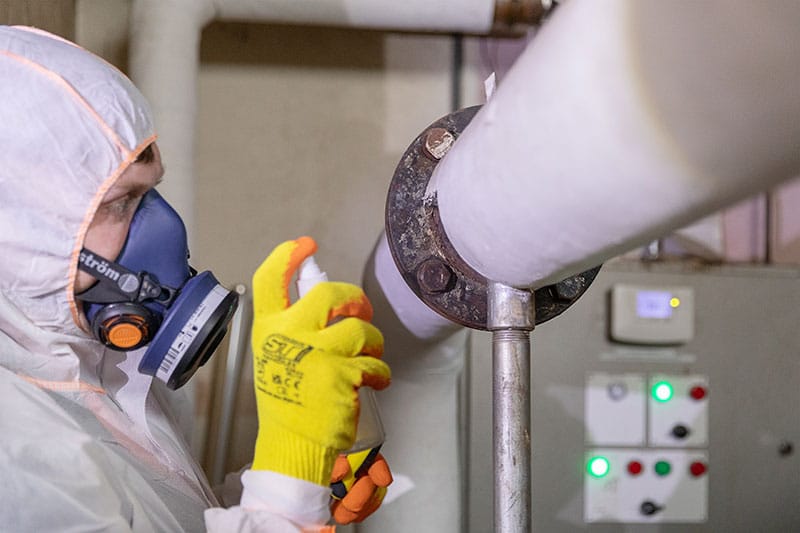Do I need to relocate during asbestos removal?
For many years, asbestos was used in building materials throughout the UK. Its durability and fireproofing abilities made it useful in construction projects.
By the mid-1960s, though, knowledge about the dangerous health risks of asbestos grew. In 1999, the UK banned the use of asbestos, though by that point, many buildings had already included asbestos-containing materials (ACMs).
Undisturbed, asbestos doesn’t pose a risk. However, when damaged, microscopic fibres release, which can cause major health complications years in the future. Having dangerous ACMs removed from a building is imperative to protecting the health of occupants.
Since asbestos is hazardous, you may be wondering if you should relocate during an asbestos removal project. The answer to that depends on a few factors, which we’ll cover in this article.

Understanding asbestos and its health risks
When asbestos fibres become airborne, people in the vicinity can breathe them in. The fibres can then stick to the person’s lung tissue. A decade or more in the future, this can cause serious and even fatal conditions, including asbestosis, lung cancer, mesothelioma, and pleural thickening. Some of these conditions, like mesothelioma, have no cure and require aggressive treatments such as chemotherapy and radiotherapy. Surgery may also be necessary.
Because of its varied uses, asbestos can be found in many areas of a building, including:
- Boiler or piping insulation
- Ceiling tiles
- Cement sheeting
- Ductwork
- Floor coverings
- Popcorn ceilings
- Textured paint
- Wall panels
The type of building can also determine where asbestos may be present. For example, CLASP buildings usually have a lot of asbestos insulating board (AIB), which was used for fireproofing steel frames.
What is involved in the asbestos removal process?
Asbestos removal should always be left to a professional or team of professionals because it’s such a high-risk job with legal guidelines to follow. The removal process usually includes the following steps:
- Identifying the type of ACM, which determines how high of a risk there is of fibre release.
- Preparing the proper equipment, including personal protective equipment (PPE) and respiratory protective equipment (RPE).
- Removing the ACM without damaging it.
- Wrapping the ACM twice using heavy-duty bags that won’t rip. Each bag should be labelled to show that there is asbestos inside.
- Bringing the asbestos waste to a licensed disposal site.
- Decontaminating the building as well as any equipment used in the removal process.
- Testing to ensure the area is free of asbestos.
Asbestos removal must be done in accordance with the guidelines from the Health and Safety Executive (HSE). These include minimising fibre release, proper labelling of the waste, and choosing a properly licensed facility to dispose of it, among other best practices. The HSE also has directions about PPE, including the type of clothing to wear and suitable RPE to use.
Factors influencing the need for relocation
Deciding to relocate during an asbestos removal project depends on a handful of factors. Overall, the safety of the building’s occupants is the largest concern. If the removal project puts occupants at risk, they’ll need to relocate.
Extent and location of ACMs in the building
In general, ACMs that are not damaged and that don’t have a likelihood of being damaged don’t have to be removed. Since removal introduces the risk of fibre release, it’s often safer to leave these ACMs where they are.
Similarly, if there is a small number of ACMs and they’re in an isolated or protected part of the building, there probably won’t be a need to remove them. According to the HSE, “Where asbestos-containing materials are assessed as being in good condition and not in a position where they are likely to be damaged, they should be left in place and monitored.”
However, ACMs that have a tendency to break down over time, such as sprayed insulation or pipe insulation should be assessed and if they are unable to be repaired and made safe should be removed. The same goes for any damaged ACMs which cannot be repaired or made safe, they should be removed.
Sometimes, ACMs that must be removed are in a difficult-to-access part of the building. In this case, the duty holder will have to work with the asbestos removal team to gain safe access. Moreover, that access shouldn’t make it possible to damage those ACMs. Both the ACMs and the workers need to remain protected when accessing hard-to-reach parts of a building.
Potential disruption to daily activities
Whether or not daily activities will be interrupted by asbestos abatement is also a consideration.
If the building is in use, such as an office building or school, it’s possible that the area being worked on can be sealed off from the rest of the building so that it can remain open.
However, if the work occurs in a part of the building that can’t be sealed off, the building won’t be open to anyone but the asbestos team. In that case, activities will either have to be relocated or put on pause.
Depending on the type of building, it may be best to schedule the removal project during a holiday when everybody will be on break.
For removal projects that cannot be isolated from the rest of the building and are projected to take a long time, it’s best to relocate activities. Otherwise, they’ll be cancelled long-term, which poses a major disruption to anyone involved.
Determining the need for relocation
The safest option is always to leave the premises during asbestos removal. However, that can be a lot easier said than done.
The following steps will help when deciding if you need to relocate during asbestos removal:
Have asbestos professionals inspect and assess the property
Your contractor will inspect your property and come up with a removal plan. The plan will include the procedures the team will follow, from preparing the area to the actual removal and decontamination post-removal. This is the first step to determining whether or not it’s possible for you to stay in the building during the project.
Evaluate the potential risks of the removal process
Asbestos is dangerous when its fibres are airborne. As work is performed, you’ll need to stay away from the work area so as not to inhale those fibres. If it’s not possible for the team to cordon off certain areas, it won’t be safe for you to be in the building.
Additionally, some utilities may be disconnected during removal. For example, it’s common for HVAC systems to be turned off so the fibres don’t get into vents. Knowing which utilities will be inactive can help you decide if you should relocate.
Collaborate with the asbestos removal contractor to determine if relocation is necessary
Your contractor will be able to go over the details of the removal project with you. Together, you can decide whether or not relocation is necessary. It’s not uncommon for removal teams to work in buildings that continue to function. In that case, the removal project is sectioned off so that asbestos doesn’t get into occupied areas.
Alternatives to relocation during asbestos removal
There are a lot of steps that an asbestos abatement team can take so that occupants don’t have to relocate. Those include:
- Using containment measures so that the asbestos removal work area is isolated from the rest of the building.
- Temporary relocating activities to different rooms or areas of the buildings.
- Blocking off vents so asbestos fibres don’t get into the HVAC system.
- Employing negative air pressure systems and specialised equipment to maintain safe air quality.
- Regularly testing air quality outside the abatement area to ensure asbestos isn’t escaping.
You’ll be able to collaborate with your asbestos removal contractor to decide the best course of action and minimise disruption to your normal activities while keeping everyone safe.
Final thoughts about the need for relocation during asbestos removal
The severity of the job at hand determines whether or not relocation is necessary. Sometimes, minimal relocation is the best solution, such as moving activities from one part of a building to another.
The safest option to prevent any exposure risk is always to leave the building unoccupied. But in the event that that’s not possible or too inconvenient, your contractor may be able to work out a plan with you so that the building can stay open.
Whatever you decide to do, make sure that a licensed professional is in charge of the asbestos abatement project. That’s the only way to ensure workers and occupants will be as safe as possible until the asbestos is gone. You’ll also know that the necessary legal guidelines are being followed.
To speak with an asbestos professional about your removal needs, contact us today.

Written by Callum McDonald
Callum McDonald is an expert in asbestos quality management, ensuring rigorous adherence to regulations and high-quality standards in removal projects. His focus on enhancing quality and client satisfaction makes him a crucial asset in safety and compliance within the field. Callum's expertise in technical support and oversight of licensed works underscores his commitment to excellence in asbestos management, providing invaluable guidance to clients in this specialised area.
